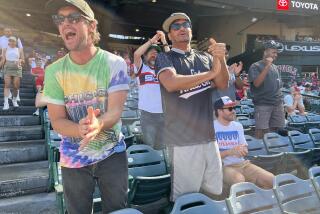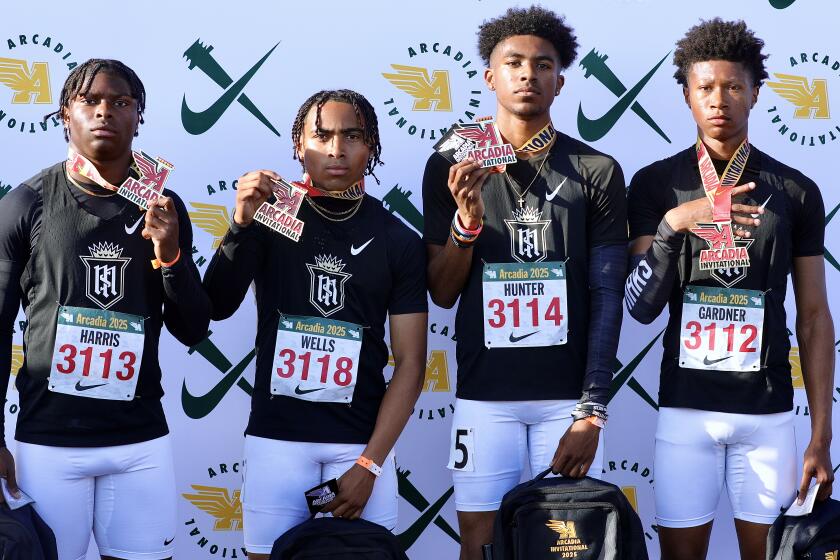Chicago’s Ready for a Little Civil War
- Share via
Those of us who live in the East like to think we created baseball and all its myths -- you know, like the curse of the Bambino that has doomed the Red Sox in their Sisyphus-like struggle to roll a large, ball-shaped boulder up the mountain straddled for eternity by the Yankees.
Ah, but right now, smack dab in the middle of the country, there is a historic -- dare I say epic -- battle for the hearts and minds of Chicagoans. The White Sox and the Cubs, South Side versus North Side, the alpha and omega of baseball, are on a course to meet in the World Series.
If you picked up your paper earlier this week, you saw the Cubs atop the National League Central, while the White Sox held the American League Central Division lead.
Unusual? It is, in fact, almost unprecedented. This is the first time since 1906 that the Cubs and the White Sox were in first place simultaneously in the month of September. And you remember what happened a month later -- that epic World Series 97 years ago: the first “trolley series,” a stunning upset by the “hitless wonders,” as the White Sox were called. They had hit seven home runs all year, while the Cubs were winning a still-record 116 games. But the Pale Hose (their tabloid sobriquet) won the series, four games to two.
The century that followed was not kind to either team: The White Sox haven’t won a series since 1917, while the Cubs last got their rings in 1908. Indeed, the White Sox haven’t even been to a World Series since 1959 -- when they faced the L.A. Dodgers -- while the Cubs were last there in 1945. Even the White Sox’s rare appearance in 1919 led to baseball’s most famous scandal -- known thereafter as the “Black Sox Scandal” -- for throwing some games. It purportedly led a young fan to plead with Shoeless Joe Jackson, “Say it ain’t so, Joe.”
The years may have blurred the distinction between the teams as far as the rest of the country is concerned. But at home, the Cubs remain the haughty tenants of Wrigley Field, in the better part of town, while the White Sox are Everyman’s team.
In a strange twist, the father of baseball-gadfly Bill Veeck once was the Cubs’ president. Young Bill actually planted the ivy along the walls in Wrigley Field. But Bill Veeck had to go elsewhere to make his name, places such as St. Louis, where he hired a midget for one day, sent him up to bat and became part of baseball lore. Veeck also ran the Indians and then, twice, the White Sox.
Twenty years later, when I was writing Veeck’s biography, I asked one of the Wrigleys whether the family ever had considered hiring the theatrical Bill Veeck to run the Cubs. “Oh, no,” was the reply. “That was not something we would do.” The Cubbies were North Side, which even today has its coffeehouses and yuppie apartments. The White Sox are hard by the South Side, not far from where the old, famed stockyards were. But both clubs have tried for so long to get it right that their annual collapses have been traditional late-summer jokes.
Back in 1959, though, when the White Sox became the last Chicago baseball team to go to a World Series, there was excitement in the air. In fact, when the Pale Hose clinched the American League pennant, the fire commissioner decreed that alarms should go off all over the city -- never mind that it was late at night. And so thousands of Chicagoans took to the streets frightened out of their wits at the clanging. Why, you’d have to go back to 1871, when Mrs. O’Leary’s cow knocked over that lantern and started the Great Fire, to see so many Chicagoans running in the streets. Of course, if those two teams were to meet again this year -- well, there’s no telling what would happen.
More to Read
Go beyond the scoreboard
Get the latest on L.A.'s teams in the daily Sports Report newsletter.
You may occasionally receive promotional content from the Los Angeles Times.










